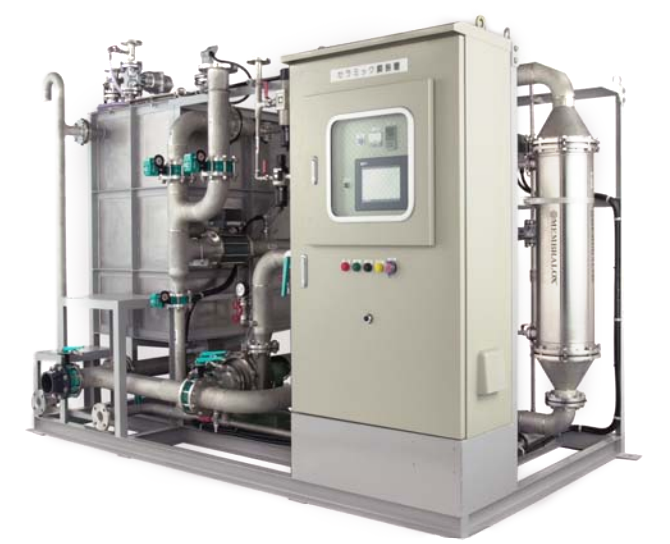Improve your process and product with crossflow technology.
Product: crossflow ultrafiltration membrane
For ink jet ink and colorant formulation, efficient filtration makes all the difference.
In recent years, ink jet ink and colorant formulators have faced an increasing number of challenges. The improved pigmented dispersions that are being developed have more complex chemistries, which cause the formation of micro-sized contaminant byproducts. Global competition has forced many ink jet ink and colorant formulators to reevaluate their processes and investigate new filtration and separation technologies to drive down processing costs. In addition, the move toward greener practices in industry has placed emphasis on water recovery and closed-loop regenerable processes.
Crossflow technology successfully addresses challenges for which traditional direct cartridge filtration is not feasible or practical. Pall Corporation is in a unique position as a supplier of a number of different crossflow technologies, among them Microza1 hollow fiber and Membralox® ceramic membranes. Having applied a number of crossflow technologies to a variety of applications in diverse industries, Pall Corporation has developed expertise in crossflow products and supporting system design.
How Crossflow Filtration Works
In crossflow filtration, an incoming feed stream passes across the surface of a crossflow membrane, and two exiting streams are generated. The permeate stream is the portion of the fluid that passes through the membrane. This filtered fluid will contain some percentage of soluble and/or insoluble components from the initial feed stream that are smaller than the membrane removal rating. The remainder of the feed stream, which does not pass through the crossflow membrane, is known as the retentate stream.
As the feed stream passes across the membrane, the transmembrane pressure (TMP) drives the separation of the fluid.2 The rapid crossflow at the active membrane layer continually sweeps away particles and other material, preventing buildup on the membrane surface.3 As a result, crossflow membranes can delay fouling and maintain stable permeate flux rates.
Advantages of Crossflow Filtration
Crossflow filtration has a number of distinctive features that are associated with significant benefits. These benefits make crossflow the preferred filtration method for certain applications involving ink jet fluids.
Crossflow Technology for Ink Jet Ink and Colorant Applications
Ink jet ink fluids are comprised of components and contaminants of various sizes. They range from 100 Da to more than 100 μm.
Crossflow technology can be used to separate these components and contaminants in the following applications.
• Removal of impurities from pigmented aqueous colorants
• Classification of pigmented dispersions for inks and colorants
• Dye purification
• Waste stream management
Removal of Impurities from Pigmented Aqueous Colorants
The process of formulating pigmented ink jet colorants includes removing low-molecular-weight impurities such as salts, excess polymer, and surfactant. Crossflow in diafiltration mode can be used to accomplish this. A membrane with the correct rating allows the impurities and carrier fluid to pass through, while retaining the pigment. The ink colorant recirculates through the crossflow module. A portion of the impurities and fluid pass through the membrane, exiting the module as the permeate stream.
In diafiltration mode, deionized (DI) water is added to replace the volume of the exiting permeate stream, and the impurities are effectively washed out of the pigmented colorant. The amount of water added is typically expressed as a multiple of the initial starting batch volume, also known as diafiltration volume. As the number of diafiltration volumes increases, the salt concentration in the retentate decreases.
Classification of Pigmented
Dispersions for Inks and Colorants Crossflow microfiltration (MF) membranes can successfully remove larger contaminants and agglomerates from pigmented dispersions. The particles that are specifically targeted are those larger than the desirable particle size distribution of the pigmented dispersion.
The pigmented dispersion passes through the membrane, and any larger contaminants and agglomerates remain in the retentate fluid. Water is continuously added to the system to maintain the concentration of the retentate fluid stream and minimize flux decay. The ink or colorant, which is the desirable product, gets diluted by the water. An additional step is then necessary to return the permeate to the initial concentration.
Dye Purification
The filtration of dyes is a necessary step in the formulation of dye-based ink jet inks and colorants. Dyes that have not been filtered may contain insoluble hard or soft particles that result from dye synthesis and mixing processes. The dye molecules, which are a low molecular weight and size, easily pass through the membrane into the permeate stream, while the larger insoluble particles become part of the retentate stream. As the dye-based ink or colorant is recirculated across the membrane, the permeate stream is collected in the form of the purified dye product. The retentate stream is concentrated into a sludge-like waste, which is disposed of.
Waste Stream Management
Wash water used in processing pigmented ink and colorant can be reclaimed by filtering it through a crossflow ultrafiltration membrane. The water passes through the membrane, and the undesirable particulate, including pigment and environmental debris, is retained and concentrated over multiple passes through the crossflow module. The filtered water can be reused as wash water or purified for use in ink or colorant formulation.




